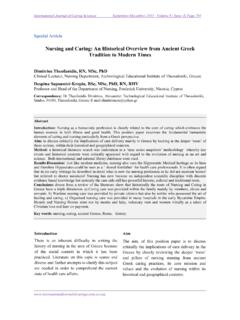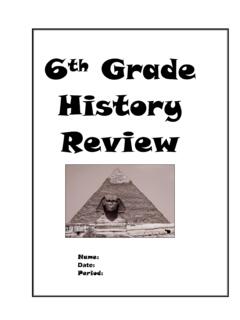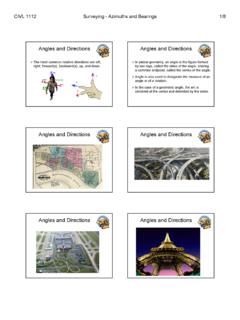Transcription of Old English Literature (500-1100)
1 CHAPTER IOld English Literature (500-1100)Old English PoetryBeowulf-typical old English verse;Caedmon - a 7th-century poet: Cynewulf-a9th-centuiy poetOld English ProseKing Alfred's works; Later annulsand religious writings; Aelfric andWulfstanOld English DramaHISTORICAL BACKGROUNDThe time period of about 500-1 100 AD in British history was characterizedby foreign invasions and internal struggles. This resulted in the mixing of severalraces, tongues and the Romans departed from the British Isles in 407 AD fightingcontinued between the Picts and the Scots who had lost their common fifth century also saw conquests and the gradual occupation by Germanictribes - Angles, Jutes and Saxons - who had moved north to Scandinavia andfrom there to Britain.
2 Apart from making conquests, these tribes preferredagricultural life, had strong family and tribal ties, and were very loyal to theirking or chief. The legendary King Arthur defeated the Saxons in 490 AD and forabout a decade halted their the end of the sixth century, the Anglo-Saxons accepted Christianityafter Pope Gregory sent Saint Augustine to Britain in 597 AD. (The Romans hadintroduced Christianity to the Celts centuries earlier.) This gave rise to somereligious the end of the eighth century the Vikings (also known as Norsemen orDanes) invaded the country, easily overcame the local inhabitants, and plunderedtheir estates.
3 It was not until the reign of King Alfred the Great (871 -900) thattheir advance was stopped. With their acceptance of Christianity, the Danespartially blended in with the local 's successors, Edgar and Ethelred II were in 1016 followed by DanishKing Canute (reigned 1016-1035), after whose death the empire fell apartAlfred's great-grandson, Edward, son of the French Emma of Normandy, tookover the throne. The fact that Edward had no descendants led to a power strugglebetween his brother-in-law, Harold, and Emma's nephew, William of 's victory over Harold at the Battle of Hastings in 1066 led to the Normanconquest and occupation of England, which then opened a new chapter in language of this whole period (500-1100) is known as Old English .
4 Noexact date exists for its beginning. The first written records of the language datefrom around 690 AD (however, people had spoken it long before then). Most OldEnglish words were Germanic, having come from the languages of the Angles,Jutes and Saxons. Latin, however, also had a strong influence on early , the Scandinavians (Vikings) contributed many words to Old English . Bythe end of the Old English period (marked by the Norman conquest), Old Englishhad been established as a literary language with a remarkable polish English Literature consists of poetry, prose, charms, riddles, maxims,proverbs, and various other wisdom sayings.
5 It is a mixture of pagan traditions,thoughts about life, the universe and nature, as well as Christian thought andmoral values. There is often no clear-cut delineation between religious andnon-religious poetry or sometimes even between poetry and English POETRYOld English poetry included long epic heroic poems, which drew on theBible as well as on pagan sources for their content. Some poetry was also basedon historical events. With a history of invasions and occupations, many writingsof this era are chronicles, annals, and historical records. Some are in the forms ofpoetry and describe various battles, for example, "The Battle of Maldon" and"The Battle of Brunanburh".
6 The themes are war, conquest and bravery. Manyeighth-century works depict Anglo-Saxon resistance against the and melancholy are frequently present in describing man's strugglesagainst his environment, life's difficulties, and the passage of time. Life isfleeting. Often a prologue and epilogue express hope in God's compassion andmercy. Examples of such poems include "The Wanderer", "The Seafarer" and"The Ruin". Other poems depict the separation of a man and a woman and theaccompanying sadness, such as in "The Wife's Lament" and "The Husband'sMessage". In these types of poem the man may have been exiled and sometimesthere is hope, sometimes not.
7 Collectively, Old English poems that lament theloss of worldly goods, glory, or human companionship are called is the best-known and best-preserved Old English verse. Caedmonand Cynewulf were well-known Old English religious poets in the 7th and 9thcentury respectively. Much Old English poetry is difficult to date and evenharder to assign to specific - Typical Old English VerseBeowulf is an epic poem of over 3,000 verses, whose manuscript dates fromabout the 10th-century. The poem is the only epic from the time that has beenpreserved as a whole. Its author is unknown, but he seems to have had a goodgrasp of the Bible and other great epics, such as Homer's work glorifies a hero and the values of bravery and generosity.
8 Thestory is set in Scandinavia around 500-600 AD - a time of battles and conquestsby Germanic Anglo-Saxon tribes in Denmark and southern Sweden. Its sourcesare old legends of these tribes who had moved north from Germany overScandinavia and into Britain. It also reflects the acceptance of Christianity bythese new British settlers at the end of the sixth first part of the story takes place in Denmark. King Hrothgar is beingpestered by a water monster, Grendel, who is killing his men. Beowulf comes tohis aid and kills Grendel and later, at the bottom of the lake, also Grendel'smother, who comes to avenge her son.
9 The second part happens in southernSweden about fifty years later. Beowulf himself is a king and has to fight afirebreathing with other Old English Literature , this epic incorporates both pagan andChristian ideas. The monster-slaying hero has his origin in two ancient fairytales. From the pagan traditions also come a love of war and the virtue ofcourage. The biblical Old Testament supplies the idea about giants and monstershaving descended from Cain's line. The poem is sometimes seen as a conflictbetween good and evil. From the Christian tradition, it incorporates morality,obedience to God, and avoidance of are many contrasts, for example, water and fire, youth and old age,life and death, rise and fall of nations and individuals, friendship and desertion,faithfulness and betrayal, heroism and cowardice, hope and resignation, good andevil, as well as the past, present and future.
10 Elegy is apparent throughout - life is passing and is full of struggles andsuffering, (This theme has an application also for modern life and the struggles ofmankind.) This is contrasted by the courage of the main hero, said to be the"kindest and noblest of earthly kings and the most desirous of praise and glory".The poem begins and ends with the funeral of a work , written in characteristic Old English verse style, has artisticmaturity and unity. It uses alliteration ( words beginning with the same sound),kennings (metaphorical descriptive phrases or compound words ), and internalrhyme (a word within a line rhyming with a word at the end of the line).





